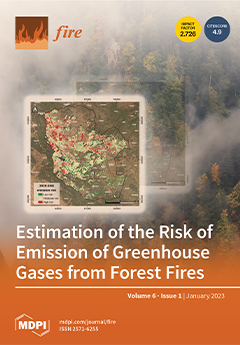Open AccessArticle
Development of a Model to Estimate the Risk of Emission of Greenhouse Gases from Forest Fires
by
Victoria Lerma-Arce, Celia Yagüe-Hurtado, Helena Van den Berg, Miguel García-Folgado, Jose-Vicente Oliver-Villanueva, Yacine Benhalima, Inês Marques-Duarte, Vanda Acácio, Francisco C. Rego, Eduardo López-Senespleda, María Menéndez-Miguélez, Ricardo Ruiz-Peinado, Thomas Petillon, Stéphanie Jalabert, Ester Carbó-Valverde, Eugenia Gimeno-García, Rebeca Aleix-Amurrio and Edgar Lorenzo-Sáez
Cited by 3 | Viewed by 3859
Abstract
While the Mediterranean basin is foreseen to be highly affected by climate change (CC) and severe forest fires are expected to be more frequent, international efforts to fight against CC do not consider forest fires’ greenhouse gas (GHG) emissions risk and the possibility
[...] Read more.
While the Mediterranean basin is foreseen to be highly affected by climate change (CC) and severe forest fires are expected to be more frequent, international efforts to fight against CC do not consider forest fires’ greenhouse gas (GHG) emissions risk and the possibility of its mitigation. This is partly due to a lack of a methodology for GHG risk spatial assessment and consideration of the high value of carbon stocks in forest ecosystems and their intrinsic risk. To revert this, an innovative GHG emission risk model has been developed and implemented in a pilot forest area. This model considers geospatial variables to build up emission vulnerability based on potential fire severity and resistance of a landscape, value at risk and the hazard of a fire occurrence. The results classify low, moderate and high emission risks in the analysed areas. This identification of hotspots allows the prioritisation of fire prevention measures in a region to maximise the reduction of GHG emissions in the case of a fire event. This constitutes the first step in a holistic and consistent CC mitigation that not only considers anthropic GHG sources but also possible GHG emissions by forest fires that can be actively prevented, managed and reduced.
Full article
►▼
Show Figures





